Evaluation of Thermal Anomalies in Multi-Boreholes Field Considering the Effects of Groundwater Flow
Abstract
:1. Introduction
2. Theory
2.1. Finite Line Source Model (FLS)
2.2. Moving Finite Line Source Model (MFLS)
2.3. Multi-BHEs Model Considering Groundwater Flow
3. Experiential Study and Validation
4. Analysis of Dynamic Cooling Load Models for Multi-BHEs
4.1. Long-term Analysis under an Annual Load Pattern
4.2. Short-term Analysis under Dynamic Diurnal Load Models
- Constant load model
- Intermittent load model
- Day-high night-low load modelwhere Ap, Apj, Apg represent the positive or negative heat flux per unit length of the three load models, (W/m), such that the absolute values of Ap, Apj, Apg are the highest magnitude of the cooling load per unit length every day.
5. Optimization for Multi-BHEs
5.1. The Optimization Model
5.2. Application of Optimization-Arrangement Optimization
5.3. Application of Optimization-Load Optimization
6. Conclusions
- The long-term performance of multi-BHEs fields under an annual dynamic load pattern was studied using the finite and the moving finite line source models. In the FLS model of a BHEs field, the rise in temperature increased from the far-field towards the center of the boreholes. In the MFLS model, the groundwater flow caused the heat to spread farther, and the heat accumulated in the downstream along the groundwater flow. For a field of 4 × 4 boreholes, the temperature rise of a downstream point was 13.8 ℃ after 5 years running, which was 6 ℃ higher than the temperature rise of the central point. It implies that the design of the distance between the boreholes and the optimization of the BHEs field must carefully consider the effects of groundwater.
- Three dynamic diurnal load models, including constant load, dynamic intermittent load, and day-high night-low load models, were considered to evaluate the temperature rise in the 4 × 4 BHEs field. Compared to the constant load model, the temperature rise of downstream point C under the intermittent load model was 2.8 ℃ lower after 15:00 h of running. When designing the multi-BHEs, the diurnal load models of different buildings should be carefully considered; this is because the different dynamic diurnal load models would lead to different characteristics of thermal anomalies.
- Combining with the MFLS multi-BHEs model with the quasi 3D model of the circulating fluid, an optimization model was established for multi-BHEs to minimize the average outlet circulating fluid temperature and to mitigate the temperature anomalies. The optimization model considering the fluid temperature variation and thermal short-circuiting between the downward leg of the pipe and the upward leg of the pipe inside the borehole would produce a more accurate estimation of the magnitude of the thermal anomalies.
Acknowledgments
Author Contributions
Conflicts of Interest
Abbreviations
| Nomenclature | |
| Tg | undisturbed subsurface temperature (℃) |
| Tb | borehole temperature (℃) |
| Tfi | inlet temperature of BHE (℃) |
| Tfo | outlet temperature of BHE (℃) |
| qL | heat flux per unit length (W/m) |
| H | borehole depth (m) |
| db | borehole diameter (m) |
| dp | branch pipe diameter (m) |
| d∞ | far-field diameter (m) |
| XC | shank spacing between the legs (m) |
| λ | thermal conductivity (W/(m·K)) |
| a | thermal diffusivity (m2/s) |
| ρc | vol. heat capacity (J/(m3/K)) |
| φ | porosity of the medium |
| u | groundwater flow velocity (m/s) |
| Rfb | the borehole resistance including pipe resistance (m2 K/W) |
| R12 | thermal short-circuiting resistance between tubes (m2 K/W) |
| Rb | effective pipe-to-borehole thermal resistance (m2 K/W) |
| Subscripts | |
| s | soil |
| g | grout |
| por | porous |
| b | borehole |
| Acronyms | |
| FLS | finite line source model |
| MLM | multilayered model |
References
- Ingersoll, L.; Zobel, O.; Ingersoll, A. Heat Conduction with Engineering, Geological and Other Applications; McGraw-Hill: New York, NY, USA, 1954. [Google Scholar]
- Deerman, J.D.; Kavanaugh, S.P. Simulation of vertical U-tube ground coupled heat pump systems using the cylindrical heat source solution. ASHRAE Trans. 1991, 97, 287–295. [Google Scholar]
- Bernier, M.A.; Pinel, P.; Labib, R.; Paillot, R. A multiple load aggregation algorithm for annual hourly simulations of GCHP systems. Hvac R Res. 2004, 10, 471–487. [Google Scholar] [CrossRef]
- Fossa, M.; Minchio, F. The effect of borefield geometry and ground thermal load profile on hourly thermal response of geothermal heat pump systems. Energy 2013, 51, 323–329. [Google Scholar] [CrossRef]
- Eskilson, P.; Claesson, J. Simulation model for thermally interacting heat extraction boreholes. Number Heat Transf. 1988, 13, 149–165. [Google Scholar]
- Zeng, H.Y.; Diao, N.R.; Fang, Z.H. A finite line-source model for boreholes in geothermal heat exchangers. Heat Transf. Asian Res. 2002, 31, 558–567. [Google Scholar] [CrossRef]
- Lamarche, L. A fast algorithm for the hourly simulations of ground-source heat pumps using arbitrary response factors. Renew. Energy 2009, 34, 2252–2258. [Google Scholar] [CrossRef]
- Bandos, T.V.; Montero, Á.; Fernández, E.; Santander, J.L.G.; Isidro, J.M.; Pérez, J.; Fernández de Córdoba, P.J.; Urchueguía, J.F. Finite line-source model for borehole heat exchangers: Effect of vertical temperature variations. Geothermics 2009, 38, 263–270. [Google Scholar] [CrossRef]
- Yavuzturk, C.; Spitler, J.D. A short time step response factor model for vertical ground loop heat exchangers. ASHRAE Trans. 1999, 105, 475–485. [Google Scholar]
- Michopoulos, A.; Kyriakis, N. Predicting the fluid temperature at the exit of the vertical ground heat exchangers. Appl. Energy 2009, 86, 2065–2070. [Google Scholar] [CrossRef]
- Monzó, P.; Mogensen, P.; Acuña, J. A novel numerical model for the thermal response of borehole heat exchanger fields. In Proceedings of the 11th IEA heat pump conference, Montréal, QC, Canada, 12–16 May 2014.
- Li, M.; Lai, A.C.K. Analytical model for short-time responses of borehole ground heat exchangers: Model development and validation. Appl. Energy 2013, 104, 510–516. [Google Scholar] [CrossRef]
- Yang, Y.; Li, M. Short-time performance of composite-medium line-source model for predicting responses of ground heat exchangers with single U-shaped tube. Int. J Therm. Sci. 2014, 82, 130–137. [Google Scholar]
- Li, M.; Li, P.; Chan, V.; Lai, A.C.K. Full-scale temperature response function (G-function) for heat transfer by borehole ground heat exchangers (GHEs) from sub-hour to decades. Appl. Energy 2014, 136, 197–205. [Google Scholar] [CrossRef]
- Hu, P.; Zha, J.; Lei, F.; Zhu, N.; Wu, T. A composite cylindrical model and its application in analysis of thermal response and performance for energy pile. Energy Build. 2014, 84, 324–332. [Google Scholar] [CrossRef]
- Lei, F.; Hu, P.F.; Zhu, N.; Wu, T.H. Periodic heat flux composite model for borehole heat exchanger and its application. Appl. Energy 2015, 151, 132–142. [Google Scholar] [CrossRef]
- Zanchini, E.; Lazzari, S. New g-functions for the hourly simulation of double U-tube borehole heat exchanger fields. Energy 2014, 70, 444–455. [Google Scholar] [CrossRef]
- Erol, S.; Hashemi, M.A.; François, B. Analytical solution of discontinuous heat extraction for sustainability and recovery aspects of borehole heat exchangers. Int. J. Therm. Sci. 2015, 88, 47–58. [Google Scholar] [CrossRef]
- Mottaghy, D.; Dijkshoorn, L. Implementing an effective finite difference formulation for borehole heat exchangers into a heat and mass transport code. Renew. Energy 2012, 45, 59–71. [Google Scholar] [CrossRef]
- Bauer, D.; Heidemann, W.; Diersch, J.G. Transient 3D analysis of borehole heat exchanger modeling. Geothermics 2011, 40, 250–260. [Google Scholar] [CrossRef]
- Pasquier, P.; Marcotte, D. Joint use of quasi-3D response model and spectral method to simulate borehole heat exchanger. Geothermics 2014, 51, 281–299. [Google Scholar] [CrossRef]
- Gehlin, S.E.A.; Hellstrom, G. Influence on thermal response test by groundwater flow in vertical fractures in hard rock. Renew. Energy 2003, 28, 2221–2238. [Google Scholar] [CrossRef]
- Diao, N.; Li, Q.Y.; Fang, Z.H. Heat transfer in ground heat exchangers with groundwater advection. Int. J. Therm. Sci. 2004, 43, 1203–1211. [Google Scholar] [CrossRef]
- Wang, H.J.; Qi, C.Y.; Du, H.P.; Gu, J.H. Thermal performance of borehole heat exchanger underground water flow: A case study from Baoding. Energy Build. 2009, 41, 1368–1373. [Google Scholar] [CrossRef]
- Chiasson, A.; O’Connell, A. New analytical solution for sizing vertical borehole ground heat exchangers in environments with significant groundwater flow: Parameter estimation from thermal response test data. Hvac&R Res. 2011, 17, 1000–1011. [Google Scholar]
- Molina-Giraldo, N.; Blum, P.; Zhu, K.; Bayer, P.; Fang, Z.H. A moving finite line source model to simulate borehole heat exchangers with groundwater advection. Int. J. Therm. Sci. 2011, 50, 2506–2513. [Google Scholar] [CrossRef]
- Angelotti, A.; Alberti, L.; Licata, I.; Antelmi, L.M. Energy performance and thermal impact of a Borehole Heat Exchanger in a sandy aquifer: Influence of the groundwater velocity. Energy Convers. Manag. 2014, 77, 700–708. [Google Scholar] [CrossRef]
- Rivera, J.A.; Blum, P.; Bayer, P. Analytical simulation of groundwater flow and land surface effects on thermal plumes of borehole heat exchangers. Appl. Energy 2015, 146, 421–433. [Google Scholar] [CrossRef]
- Zanchini, E.; Lazzari, S.; Priarone, A. Long-term performance of large borehole heat exchanger fields with unbalanced seasonal loads and groundwater flow. Energy 2012, 38, 66–77. [Google Scholar] [CrossRef]
- Capozza, A.; De Carli, M.; Zarrella, A. Investigations on the influence of aquifers on the ground temperature in ground-source heat pump operation. Appl. Energy 2013, 107, 350–363. [Google Scholar] [CrossRef]
- Hecht-Mendez, J.; de Paly, M.; Beck, M.; Bayer, P. Optimisation of energy extraction for vertical closed-loop geothermal systems considering groundwater flow. Energy Convers. Manag. 2013, 66, 1–10. [Google Scholar] [CrossRef]
- Dagdas, A. Heat exchanger optimization for geothermal district heating systems: A fuel saving approach. Renew. Energy 2007, 32, 1020–1028. [Google Scholar] [CrossRef]
- Desideri, U.; Sorbi, N.; Arcioni, L.; Leonardi, D. Feasibility study and numerical simulation of a ground source heat pump plant, applied to a residential building. Appl. Therm. Eng. 2011, 31, 3500–3510. [Google Scholar] [CrossRef]
- Herbert, A.; Arthur, S.; Chillingworth, G. Thermal modelling of large scale exploitation of ground source energy in urban aquifers as a resource management tool. Appl. Energy 2013, 109, 94–105. [Google Scholar] [CrossRef]
- Montagud, C.; Corberán, J.M.; Ruiz-Calvo, F. Experimental and modeling analysis of a ground source heat pump system. Appl. Energy 2013, 109, 328–236. [Google Scholar] [CrossRef]
- Man, Y.; Yang, H.; Wang, J.; Fang, Z. In situ operation performance test of ground coupled heat pump system for cooling and heating provision in temperate zone. Appl. Energy 2012, 97, 913–920. [Google Scholar] [CrossRef]
- Shang, Y.; Dong, M.; Li, S. Intermittent experimental study of a vertical ground source heat pump system. Appl. Energy 2014, 136, 628–635. [Google Scholar] [CrossRef]
- Ally, M.R.; Munk, J.D.; Baxter, V.D.; Gehl, A.C. Exergy analysis of a two-stage ground source heat pump with a vertical bore for residential space conditioning under simulated occupancy. Appl. Energy 2015, 155, 502–514. [Google Scholar] [CrossRef]
- Lazzari, S.; Priarone, A.; Zanchini, E. Long-term performance of BHE (borehole heat exchanger) fields with negligible groundwater movement. Energy 2010, 35, 4966–4974. [Google Scholar] [CrossRef]
- Fan, R.; Jiang, Y.Q.; Yao, Y.; Shiming, D.; Ma, Z.L. A study on the performance of a geothermal heat exchanger under coupled heat conduction and groundwater advection. Energy 2007, 32, 2199–2209. [Google Scholar] [CrossRef]
- Choi, J.C.; Park, J.; Lee, S.R. Numerical evaluation of the effects of groundwater flow on borehole heat exchanger arrays. Renew. Energy 2013, 52, 230–240. [Google Scholar] [CrossRef]
- Rybach, L.; Eugster, W.J. Sustainability aspects of geothermal heat pump operation, with experience from Switzerland. Geothermics 2010, 39, 365–369. [Google Scholar] [CrossRef]
- Man, Y.; Yang, H.X.; Spitler, J.D. Feasibility study on novel hybrid ground coupled heat pump system with nocturnal cooling radiator for cooling load dominated buildings. Appl. Energy 2011, 88, 4160–4171. [Google Scholar]
- Allaerts, K.; Coomans, M.; Salenbien, R. Hybrid ground-source heat pump system with active air source regeneration. Energy Convers. Manag. 2015, 90, 230–237. [Google Scholar] [CrossRef]
- Macíaa, A.; Bujedo, L.A.; Magraner, T.; Chamorro, C.R. Influence parameters on the performance of an experimental solar-assisted ground-coupled absorption heat pump in cooling operation. Energy Build. 2013, 66, 282–288. [Google Scholar] [CrossRef]
- Yu, M.Z.; Zhang, K.; Cao, X.Z.; Hu, A.J.; Cui, P.; Fang, Z.H. Zoning operation of multiple borehole ground heat exchangers to alleviate the ground thermal accumulation caused by unbalanced seasonal loads. Energy Build. 2016, 110, 345–352. [Google Scholar] [CrossRef]
- Beck, M.; Bayer, P.; de Paly, M.; Hecht-Méndez, J.; Zell, A. Geometric arrangement and operation mode adjustment in low-enthalpy geothermal borehole fields for heating. Energy 2013, 49, 434–443. [Google Scholar] [CrossRef]
- Bayer, P.; De Paly, M.; Beck, M. Strategic optimization of borehole heat exchanger field for seasonal geothermal heating and cooling. Appl. Energy 2014, 136, 445–453. [Google Scholar] [CrossRef]
- Zhang, W.; Yang, H.X.; Lu, L.; Fang, Z.H. The analysis on solid cylindrical heat source model of foundation pile ground heat exchangers with groundwater flow. Energy 2013, 55, 417–425. [Google Scholar] [CrossRef]
- Rivera, J.A.; Blum, P.; Bayer, P. Ground energy balance for borehole heat exchangers: Vertical fluxes, groundwater and storage. Renew. Energy 2015, 83, 1341–1351. [Google Scholar] [CrossRef]
- Li, Y.; Mao, J.F.; Geng, S.B.; Han, X.; Zhang, H. Evaluation of thermal short-circuiting and influence on thermal response test for borehole heat exchanger. Geothermics 2014, 50, 136–147. [Google Scholar] [CrossRef]
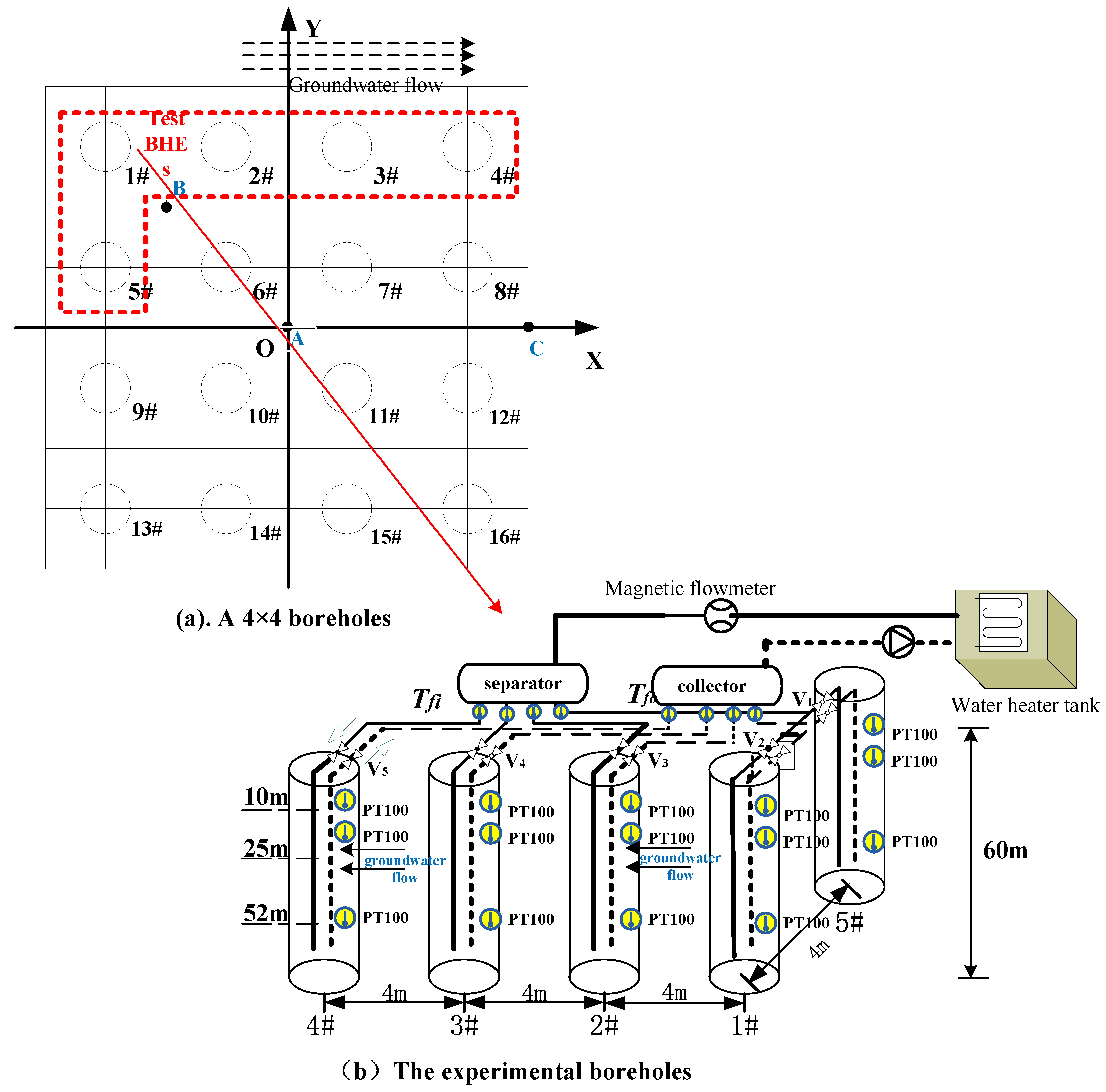

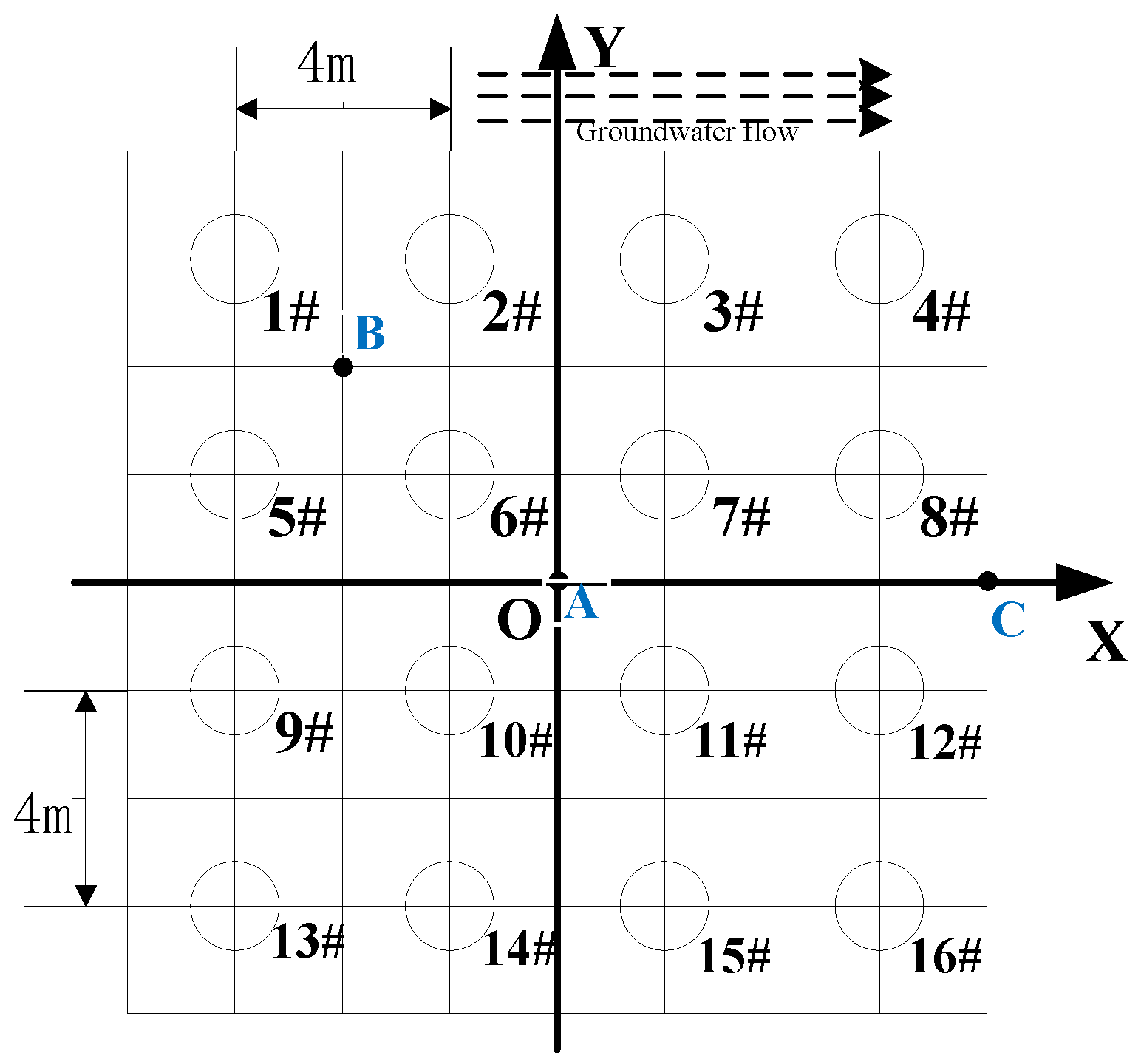

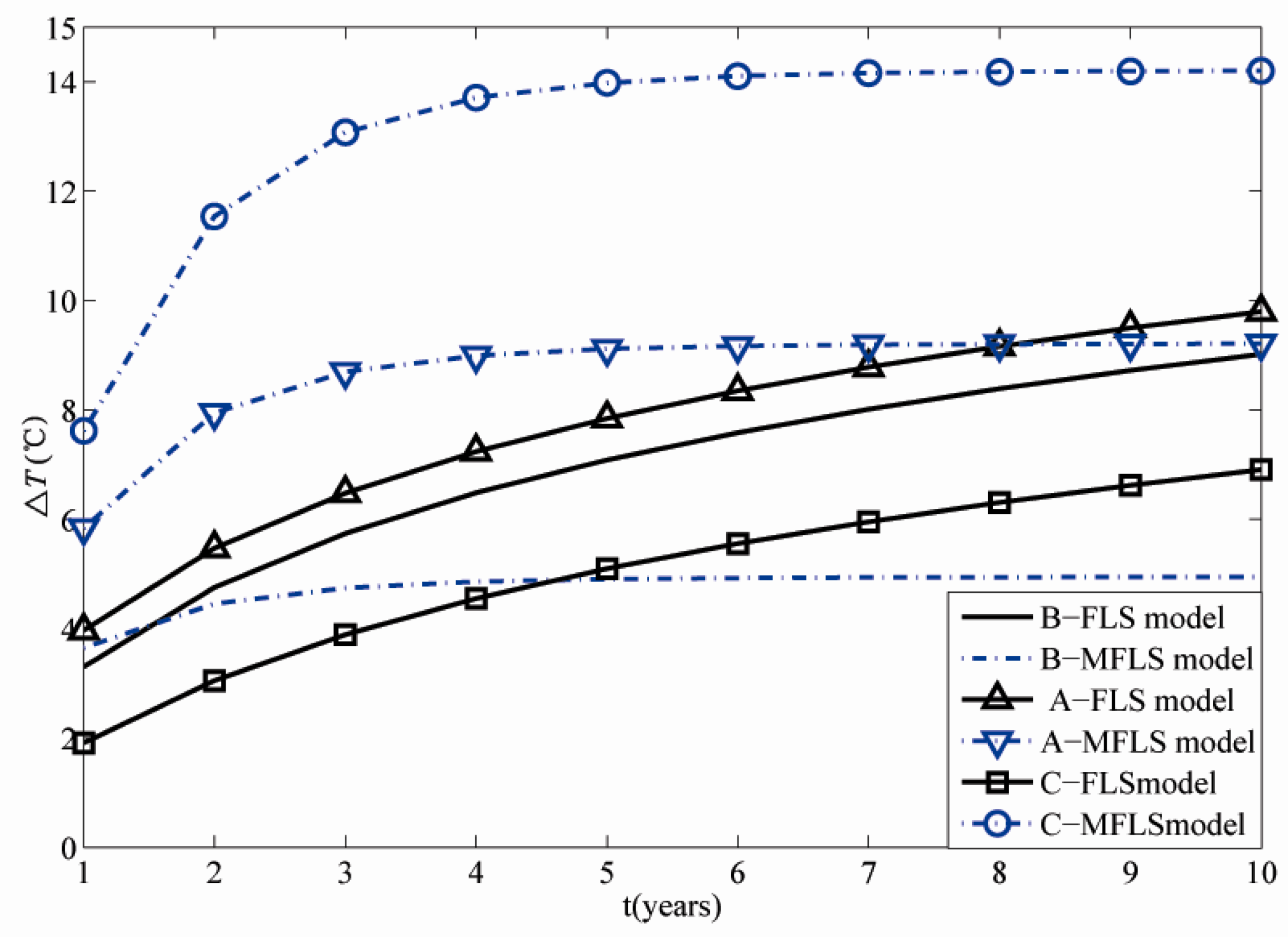
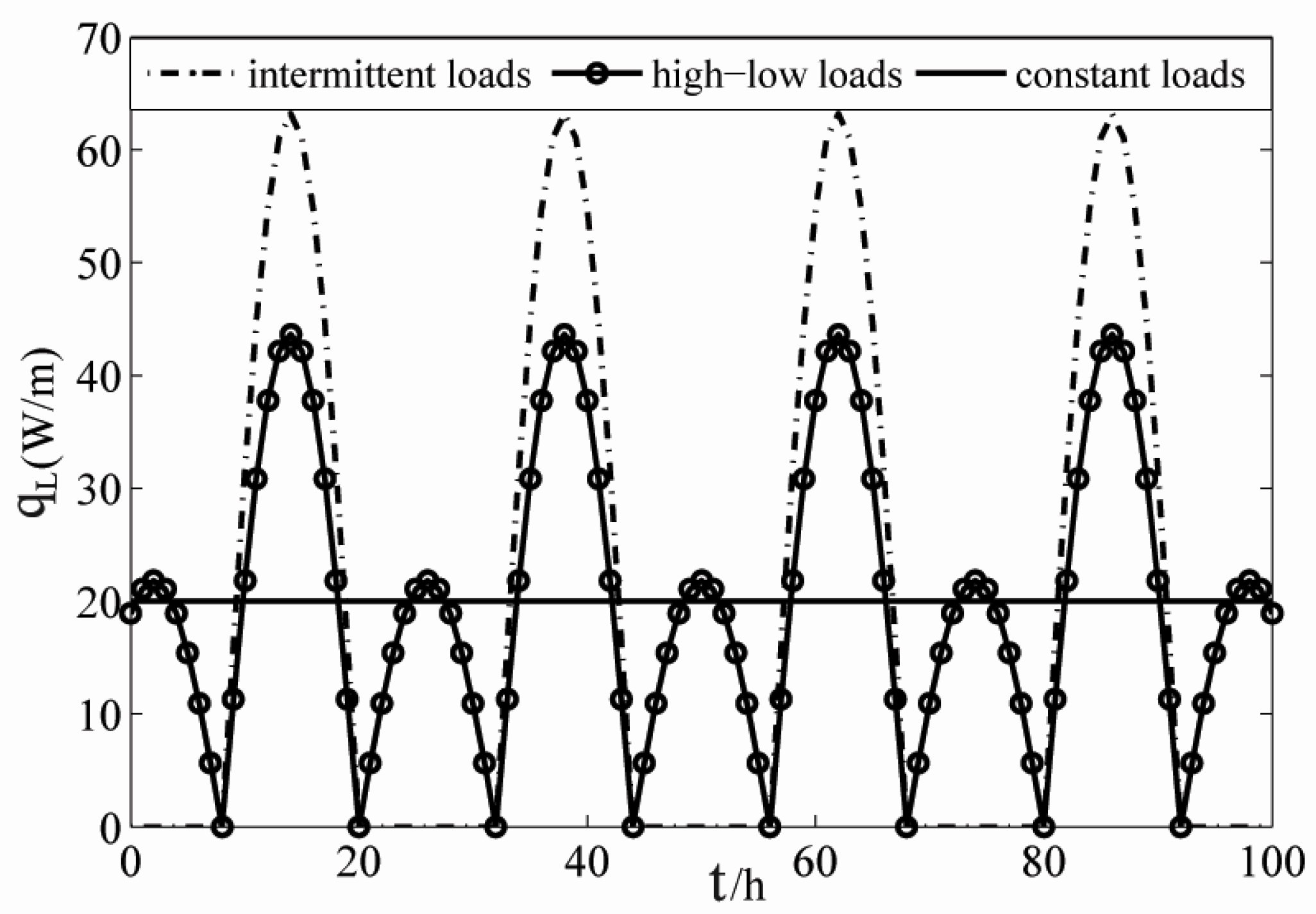


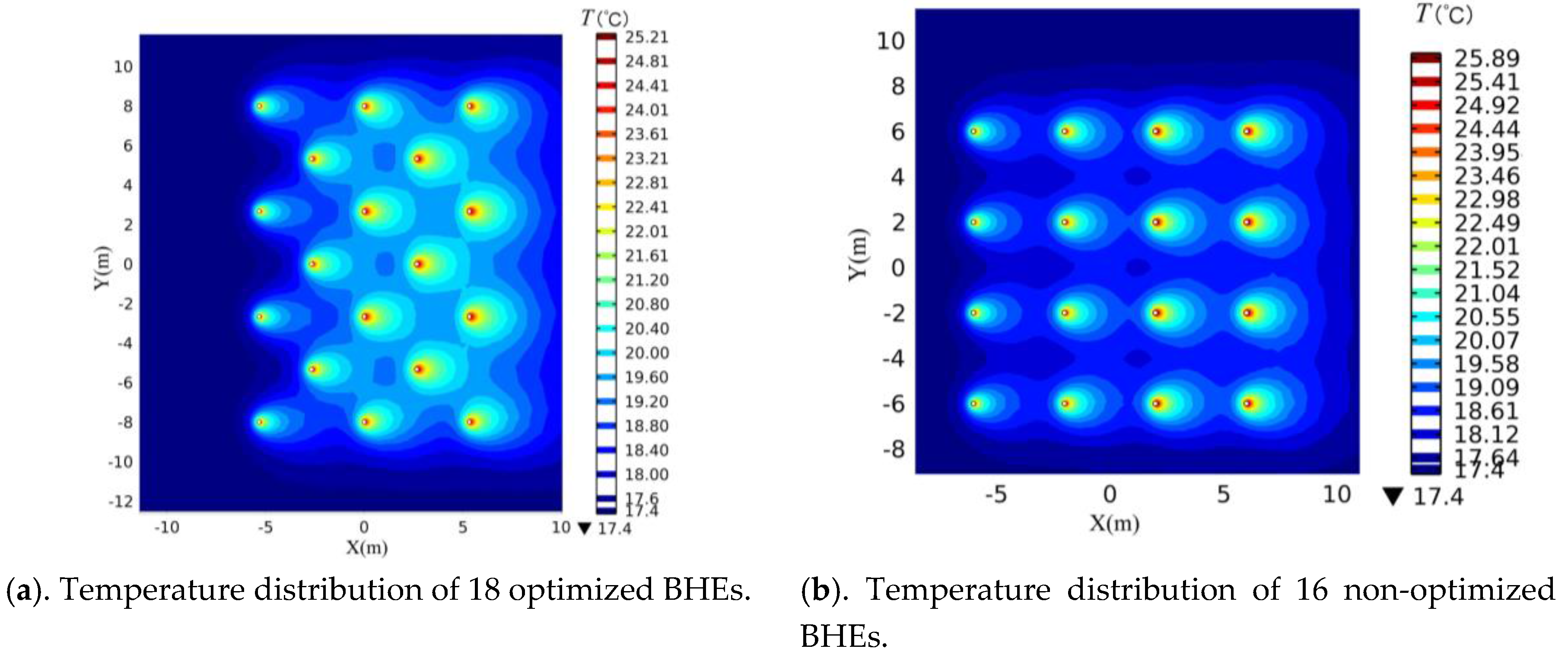
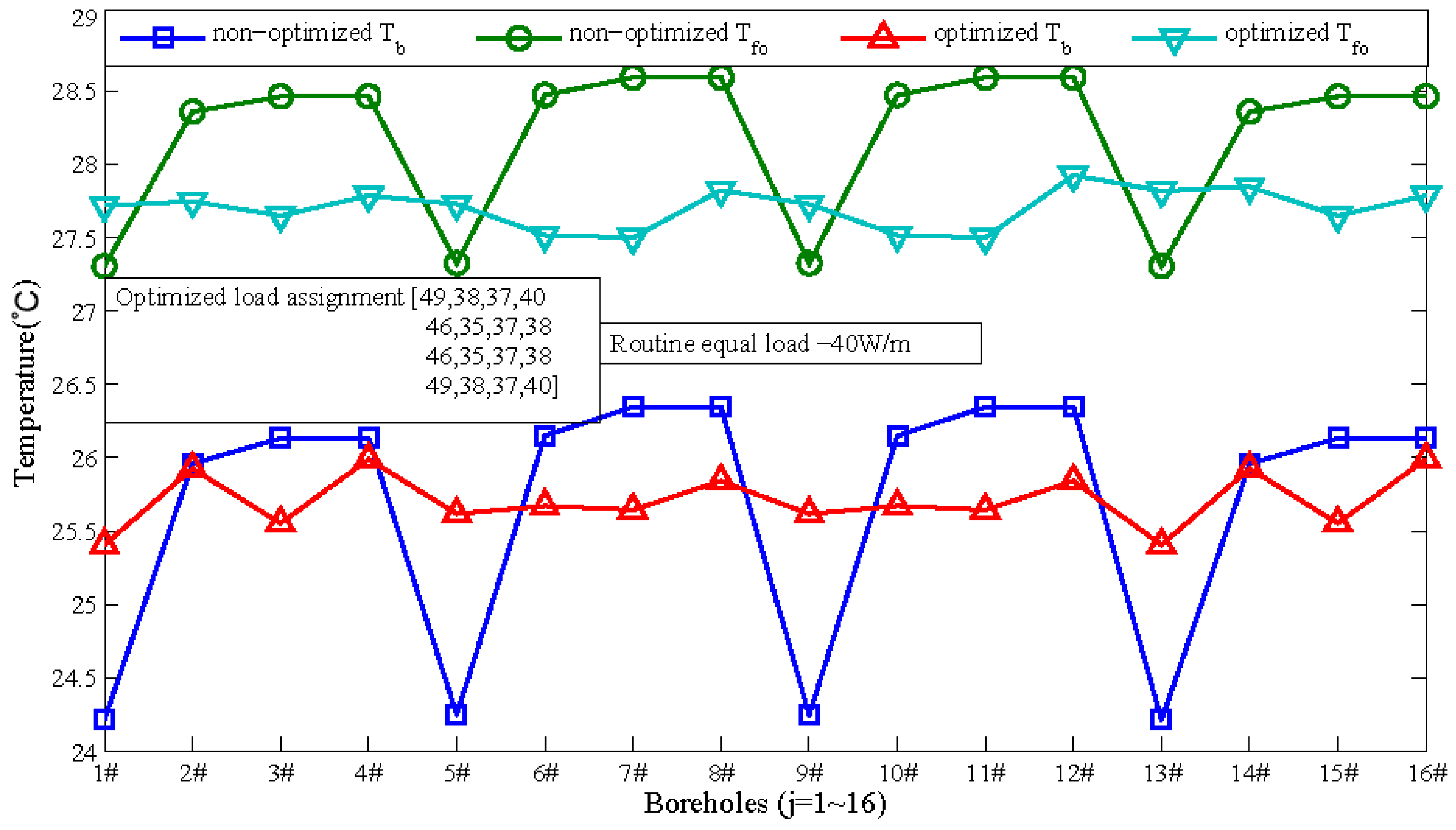
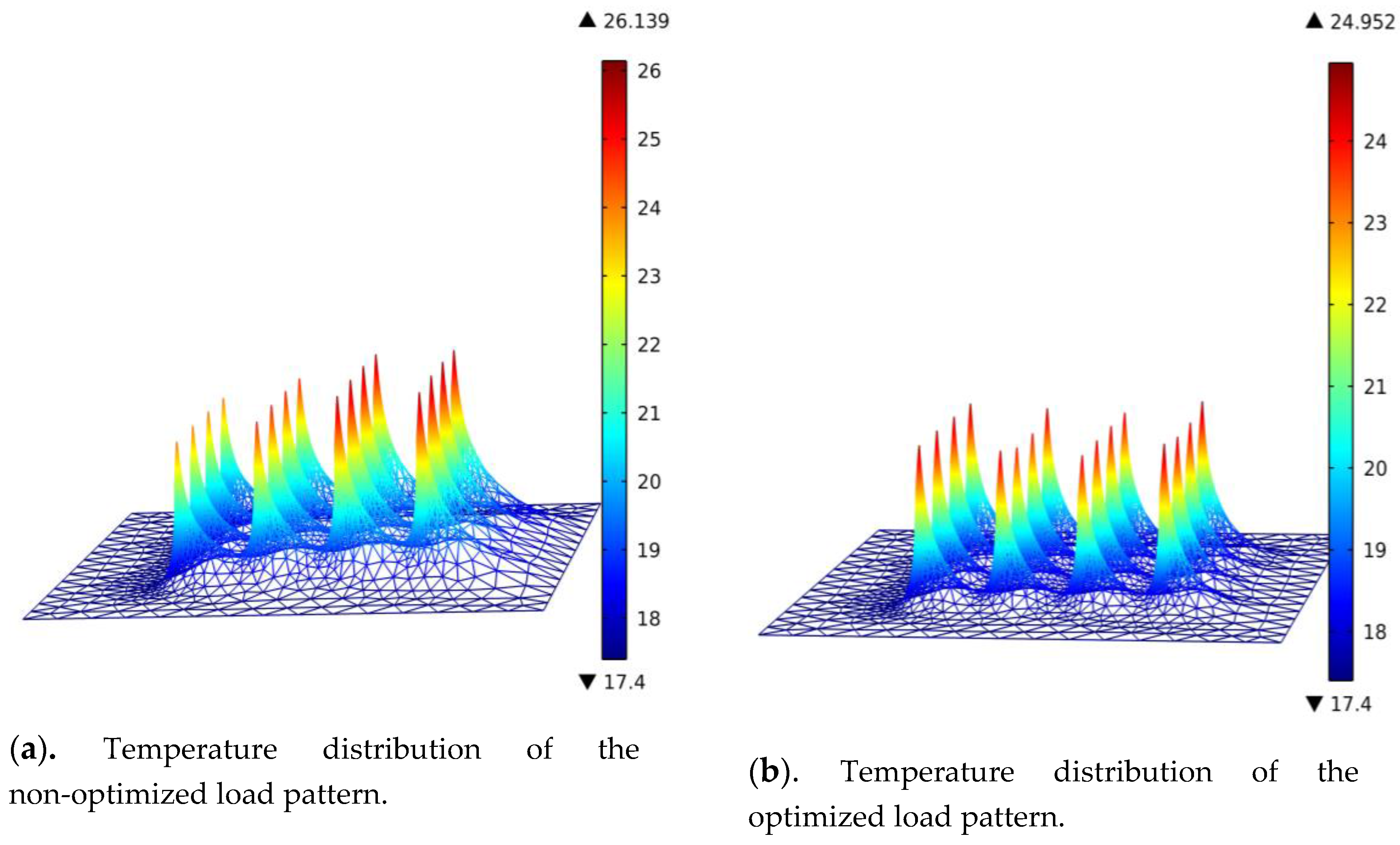
| Parameter | Symbol | Unit | Value |
|---|---|---|---|
| undisturbed soil temperature | Tgr | [℃] | 16.5 |
| borehole diameter | db | [m] | 0.20 |
| branch pipe outer diameter | dp | [m] | 0.032 |
| pipe thickness | δ | [m] | 0.0025 |
| Shank spacing | xc | [m] | 0.064 |
| grout thermal conductivity | λg | [W/m.K] | 2.4 |
| grout vol. heat capacity | ρgcg | [J/m3/K] | 3.2 × 106 |
| soil thermal conductivity | λs | [W/m.K] | 2.0 |
| soil vol. heat capacity | ρscs | [J/m3/K] | 4.8 × 106 |
| pipe thermal conductivity | λp | [W/m.K] | 0.6 |
| borehole length | H | [m] | 60 |
| heat flux per unit length | qL | [W/m] | 30 |
| groundwater flow velocity | u | [m/s] | 2 × 10−7 |
| porosity | φ | - | 0.25 |
| Dimensionless Parameters | Dimensionless Parameters |
|---|---|
© 2016 by the authors; licensee MDPI, Basel, Switzerland. This article is an open access article distributed under the terms and conditions of the Creative Commons Attribution (CC-BY) license (http://creativecommons.org/licenses/by/4.0/).
Share and Cite
Geng, S.; Li, Y.; Han, X.; Lian, H.; Zhang, H. Evaluation of Thermal Anomalies in Multi-Boreholes Field Considering the Effects of Groundwater Flow. Sustainability 2016, 8, 577. https://doi.org/10.3390/su8060577
Geng S, Li Y, Han X, Lian H, Zhang H. Evaluation of Thermal Anomalies in Multi-Boreholes Field Considering the Effects of Groundwater Flow. Sustainability. 2016; 8(6):577. https://doi.org/10.3390/su8060577
Chicago/Turabian StyleGeng, Shibin, Yong Li, Xu Han, Huiliang Lian, and Hua Zhang. 2016. "Evaluation of Thermal Anomalies in Multi-Boreholes Field Considering the Effects of Groundwater Flow" Sustainability 8, no. 6: 577. https://doi.org/10.3390/su8060577
APA StyleGeng, S., Li, Y., Han, X., Lian, H., & Zhang, H. (2016). Evaluation of Thermal Anomalies in Multi-Boreholes Field Considering the Effects of Groundwater Flow. Sustainability, 8(6), 577. https://doi.org/10.3390/su8060577





